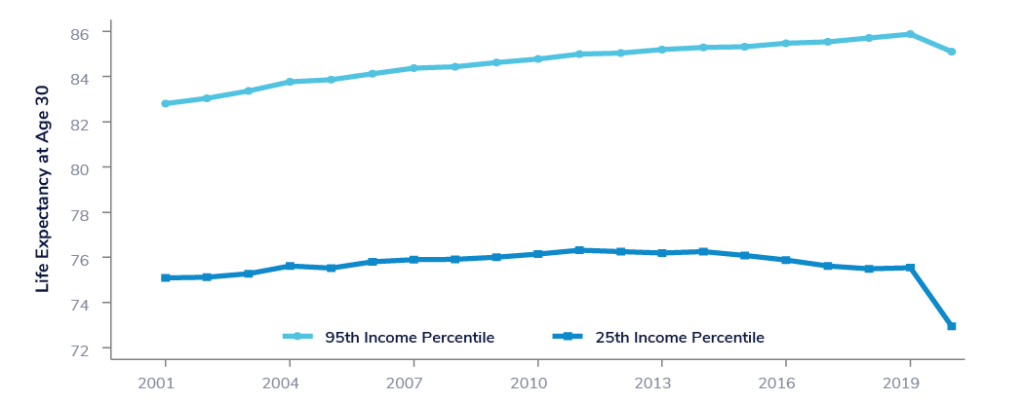A new database to measure the association between income, race, and mortality: Inequality in longevity during and beyond the COVID-19 pandemic
Principal Investigator

Raj Chetty
William A. Ackman Professor of Economics, Harvard University
Co-Investigators
- Michael Stepner, Assistant Professor of Economics, University of Toronto
- Nathaniel Hendren, Professor of Economics, Harvard University
- John Friedman, Professor of Economics, Brown University
- Maria Polyakova, Assistant Professor of Health Policy, Stanford University
Funded By
The problem:
The COVID-19 pandemic shed light on existing racial and socioeconomic disparities in health. While life expectancy has been steadily increasing over the past two decades on average, life expectancy is notably lower for under-resourced and marginalized communities. The research team hypothesized that COVID-19 would exacerbate these disparities—widening gaps in health outcomes, like life expectancy, across identities. To better understand these disparities, the researchers aim to:
• publish a new database of mortality rates from 2001 – 2020 by age, income, race, ethnicity, gender, and county;
• characterize the short-term effects of the COVID-19 pandemic on mortality rates by race and income in the pandemic period (2020 – 2021); and
• measure the long-term effects of post-pandemic changes in health, health behaviors, labor income, tax and transfer policies, and behaviors on racial and socioeconomic inequality in mortality.
The approach:
To construct the database and measure short- and long-term effects of the COVID-19 pandemic, the researchers linked data from the census, tax returns, and social security death records. The sample size included approximately 150 million Americans aged 30 – 95 collected from 2001 – 2020. The team studied life expectancy based on income, socioeconomic status, and race from 2001 onward. To analyze if COVID-19 set back recent increases in life expectancy, the team used the linked data to predict age at death conditional on income, race, and gender at age 30.
The findings:
After the pandemic’s onset, life expectancy decreased more for the lowest income Americans compared to high income individuals.
To analyze Black-White differences in life expectancy, the researchers reweighted the income distribution of Black individuals to match the income distribution of White individuals. Controlling for income, life expectancy converged between 2001 and 2019 for White and Black Americans. With the onset of the pandemic, the racial gap reopened. Weighted life expectancy for Black Americans dropped almost three times more than for White Americans.
Other racial and ethnic groups have also been disproportionately affected by the pandemic. For example, life expectancy decreased more among low-income Hispanic and American Indian and Alaskan Native populations than mid- to high-income populations of the same race. These within-race differences were far greater for minorities than for their White counterparts.

Infographic titled “Impact of COVID-19 on period life expectancy by income: Men, all races and ethnicities.”
X-axis labeled with every three years from 2001 to 2019
Y-axis labeled “Life Expectancy at Age 30”
Two lines, one for “95th Income Percentile” and one for “25th Income Percentile” showing a dip in both bars around 2019-2020